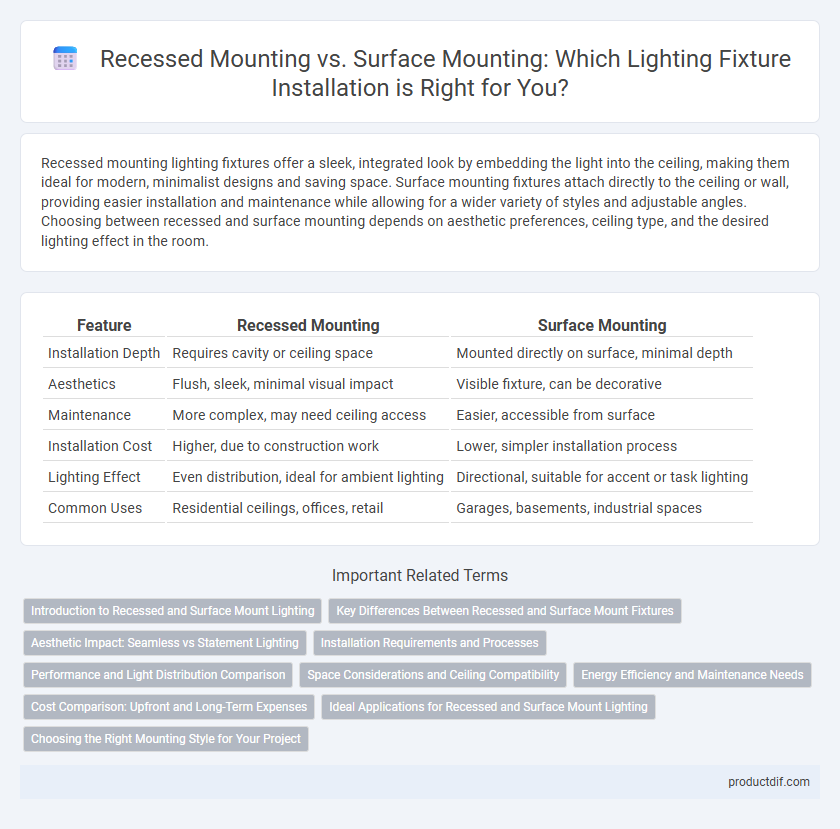Recessed mounting lighting fixtures offer a sleek, integrated look by embedding the light into the ceiling, making them ideal for modern, minimalist designs and saving space. Surface mounting fixtures attach directly to the ceiling or wall, providing easier installation and maintenance while allowing for a wider variety of styles and adjustable angles. Choosing between recessed and surface mounting depends on aesthetic preferences, ceiling type, and the desired lighting effect in the room.
Table of Comparison
| Feature | Recessed Mounting | Surface Mounting |
|---|---|---|
| Installation Depth | Requires cavity or ceiling space | Mounted directly on surface, minimal depth |
| Aesthetics | Flush, sleek, minimal visual impact | Visible fixture, can be decorative |
| Maintenance | More complex, may need ceiling access | Easier, accessible from surface |
| Installation Cost | Higher, due to construction work | Lower, simpler installation process |
| Lighting Effect | Even distribution, ideal for ambient lighting | Directional, suitable for accent or task lighting |
| Common Uses | Residential ceilings, offices, retail | Garages, basements, industrial spaces |
Introduction to Recessed and Surface Mount Lighting
Recessed mounting involves installing lighting fixtures within ceilings or walls, creating a seamless and streamlined appearance ideal for modern and minimalist designs. Surface mount lighting fixtures are attached directly to the ceiling or wall surface, offering easier installation and versatility for various spaces including offices, kitchens, and garages. Both recessed and surface mount options provide effective illumination but differ in aesthetic impact, installation complexity, and maintenance accessibility.
Key Differences Between Recessed and Surface Mount Fixtures
Recessed mounting fixtures are installed flush within ceilings or walls, providing a sleek, minimalist appearance that saves space and reduces glare. Surface mounting fixtures are affixed directly onto surfaces, allowing for easier installation and maintenance but resulting in a more prominent visual presence. Key differences include installation complexity, aesthetic impact, and suitability for various ceiling types and room designs.
Aesthetic Impact: Seamless vs Statement Lighting
Recessed mounting offers a seamless aesthetic by integrating lighting fixtures flush with ceilings or walls, creating a clean and unobtrusive look ideal for modern interiors. Surface mounting makes a bold statement with fixtures that protrude visibly, adding decorative elements that enhance architectural features and complement interior design themes. Choosing between recessed and surface mounting significantly influences the overall ambiance and visual appeal of a space.
Installation Requirements and Processes
Recessed mounting requires creating a ceiling cavity to house the lighting fixture, involving precise cutouts and integration with ceiling materials, which often necessitates professional installation to ensure proper electrical connections and structural support. Surface mounting simplifies installation by attaching the fixture directly onto the wall or ceiling surface, making it ideal for retrofit projects or locations where ceiling modification is impractical. Both methods must comply with local electrical codes, but recessed fixtures typically demand more complex wiring and insulation considerations compared to surface-mounted options.
Performance and Light Distribution Comparison
Recessed mounting fixtures offer a sleek, integrated look with superior glare control and focused light distribution, ideal for ambient and task lighting in modern interiors. Surface mounting fixtures provide easier installation and maintenance while delivering broader light dispersion suitable for general illumination in large or higher-ceiling spaces. Performance differences center on heat dissipation and beam control, where recessed lighting often benefits from housing that enhances thermal management and directional lighting, whereas surface mounts maximize coverage with simpler housings.
Space Considerations and Ceiling Compatibility
Recessed mounting requires ceiling cavity space, making it suitable for drop or false ceilings but challenging for shallow or concrete slabs due to limited clearance. Surface mounting is ideal for low-clearance ceilings, as fixtures attach directly to the ceiling surface without needing extra depth. Choosing between these methods depends on ceiling height, material, and available space to ensure proper installation and aesthetic integration.
Energy Efficiency and Maintenance Needs
Recessed mounting fixtures offer superior energy efficiency by minimizing light loss through seamless integration into ceilings, which enhances directional lighting and reduces wattage requirements. Surface mounting fixtures, while easier to install and maintain, often consume more energy due to their exposed positioning that diffuses light less effectively. Maintenance needs for recessed lighting are generally lower because the fixtures are protected from dust and impact, whereas surface-mounted lights require more frequent cleaning and bulb replacements due to greater exposure.
Cost Comparison: Upfront and Long-Term Expenses
Recessed mounting typically involves higher upfront costs due to the need for ceiling modifications and professional installation, whereas surface mounting offers a more budget-friendly initial investment, requiring minimal structural changes. Over the long term, recessed fixtures may incur additional expenses related to maintenance and repairs within the ceiling, while surface-mounted lights generally allow easier access, reducing labor costs over time. Evaluating total cost of ownership should consider both installation complexity and maintenance frequency to determine the most economical lighting fixture solution.
Ideal Applications for Recessed and Surface Mount Lighting
Recessed mounting is ideal for minimalist design spaces, offering a sleek, flush installation perfect for low ceilings and modern interiors where unobtrusive lighting is desired. Surface mount lighting works best in areas requiring easy access for maintenance or in rooms with structural limitations that prevent recessed installation, such as exposed beam ceilings or dropped ceilings. Commercial spaces and offices often utilize recessed lighting for general illumination, while surface mounts are favored in garages, workshops, and retail environments for their versatility and ease of installation.
Choosing the Right Mounting Style for Your Project
Recessed mounting offers a sleek, integrated look by embedding the lighting fixture into ceilings or walls, ideal for modern, minimalist designs requiring flush finishes and space-saving solutions. Surface mounting provides easier installation and maintenance, suitable for projects with ceilings that cannot accommodate recessing or for adding statement fixtures with visible hardware. Evaluating ceiling type, aesthetic preference, and maintenance access helps determine the optimal mounting style for lighting efficiency and design coherence.
Recessed Mounting vs Surface Mounting Infographic

 productdif.com
productdif.com